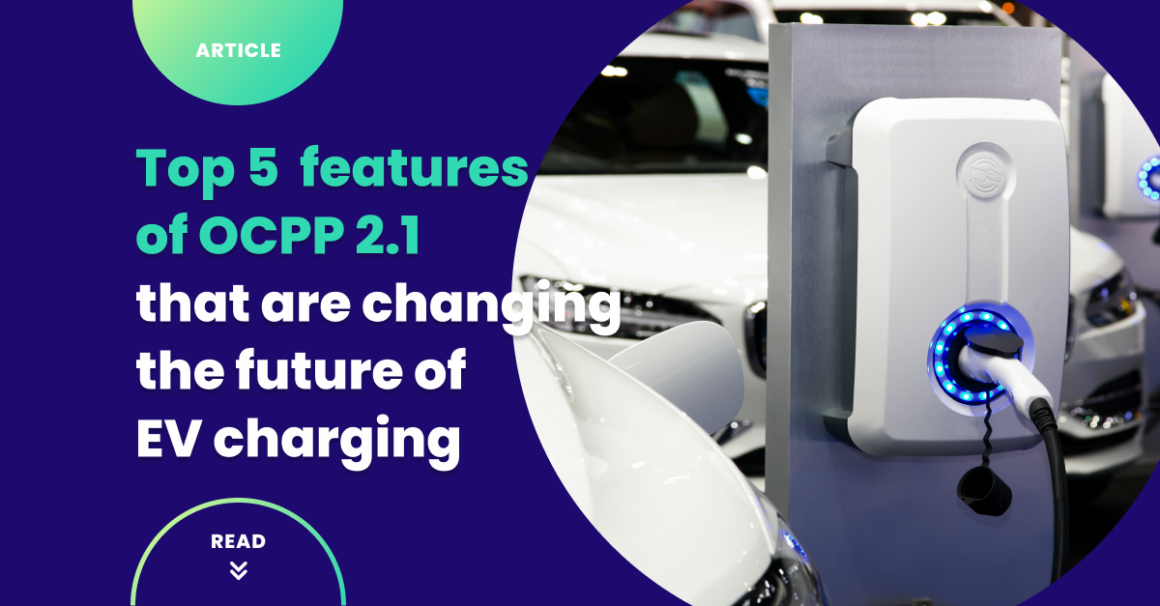Top 5 game-changing features of OCPP 2.1 that are shaping the future of EV charging

The latest version of the Open Charge Point Protocol (OCPP 2.1) brings significant enhancements to EV charging infrastructure, boosting the overall interoperability between charging stations and charging management systems (CPMS). With support for advanced features such as Vehicle-to-Grid (V2G) charging, bidirectional energy transfer, and enhanced payment systems, OCPP 2.1 positions itself as a key driver for the future of EV charging. This update strengthens the connection between EV charging and the broader energy market while making it easier for charge point operators (CPOs) to comply with grid regulations and provide reliable, efficient services.
Watch the video to learn more or read the article below for all the details:
ISO15118-20 support for V2G
V2G (Vehicle-to-Grid) support has finally been integrated into the OCPP specification, enabling bidirectional charging. This opens new possibilities for grid management, energy market participation, and emergency applications. ISO15118-20 supports both residential scenarios, such as controlling energy flow from EVs in V2H (Vehicle-to-Home) settings, and public scenarios, where EVs can be used to stabilize the grid and influence energy markets. Standardized control via OCPP ensures improved interoperability, leading to wider adoption of this technology and positioning EVs as distributed energy storage assets.
DER support
With OCPP 2.1, EV charging stations can now act as Distributed Energy Resources (DERs), facilitating bidirectional energy transfer. Compliance with local grid codes is mandatory for DERs, which includes responding to specific grid conditions through predefined settings and curves. Utilities can now control these settings through protocols like IEEE 2030.5, making it easier to integrate EV charging stations into the grid. The new OCPP version allows utilities to treat these charging stations as integral DERs, enhancing the overall reliability of the energy grid.
Local payments & prepaid support
OCPP 2.1 introduces greater flexibility for payment integration at charging stations. Whether through built-in payment terminals, external systems, or payment websites, station operators can now set specific transaction limits like maximum cost or energy usage. This feature allows for greater control even in offline scenarios, ensuring a seamless experience for EV drivers while enhancing the management of EV charging infrastructure.
Structured tariffs & local cost calculation
The latest update in OCPP 2.1 includes structured tariff information that aligns with protocols like OICP and OCPI, used in roaming scenarios. This advancement enables charging stations to display tariffs more clearly and accurately calculate the cost of charging sessions in real-time. With structured tariffs, EV drivers benefit from more transparent pricing, while operators can more effectively manage and monitor tariff-based energy consumption.
OCPP 2.0.1 compatibility
OCPP 2.1 builds upon the 2.0.1 version, offering a smoother transition compared to the leap from OCPP 1.6 to 2.0.1. Since there are fewer changes to the core message flows, the migration process is significantly simplified. New features can be implemented on top of OCPP 2.0.1, and backward compatibility ensures that if both the charging station and CPMS support OCPP 2.1, they will communicate seamlessly; otherwise, they will revert to 2.0.1, reducing the complexity for operators upgrading their EV charging infrastructure.
Evolvin EV charging landscape with OCPP 2.1
As the EV charging landscape continues to evolve, adopting OCPP 2.1 will become crucial for ensuring interoperability, optimizing energy management, and enhancing user experiences. Whether it’s integrating bidirectional charging with V2G capabilities, treating charging stations as Distributed Energy Resources, or implementing advanced payment and tariff structures, these innovations represent the future of EV charging infrastructure.
Ready to explore how these latest innovations can elevate your EV infrastructure strategy?
At Codibly, we are ready to help you implement these OCPP 2.1 enhancements. We are ready to implement OCPP 2.0.1 and/or OCPP 2.1 starting from a couple of weeks timeframe using our open-source accelerators. Ou expertise in software development for the EV and renewable energy sectors, combined with our membership in the Open Charge Alliance (OCA), positions us as the ideal partner for deploying these advanced charging solutions. Let us help you navigate the complexities of this evolving technology and unlock the full potential of your EV infrastructure.
Contact us today to discuss how we can help you leverage these advancements for your business.
contact us
Need expert guidance on your next energy project?
Reach out to us and discover how Codibly can offer tailored solutions to drive your business.